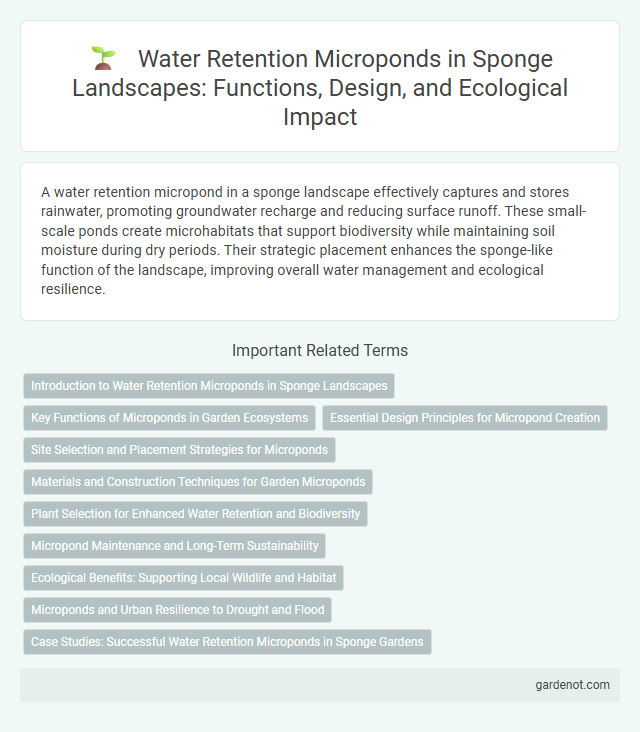A water retention micropond in a sponge landscape effectively captures and stores rainwater, promoting groundwater recharge and reducing surface runoff. These small-scale ponds create microhabitats that support biodiversity while maintaining soil moisture during dry periods. Their strategic placement enhances the sponge-like function of the landscape, improving overall water management and ecological resilience.
Introduction to Water Retention Microponds in Sponge Landscapes
Water retention microponds in sponge landscapes serve as small-scale reservoirs designed to capture and store rainfall, enhancing groundwater recharge and reducing surface runoff. These microponds play a crucial role in maintaining soil moisture, supporting local biodiversity, and mitigating flood risks in urban and rural environments. Strategically integrated into natural or engineered sponge systems, they optimize water management by balancing ecological and hydrological functions.
Key Functions of Microponds in Garden Ecosystems
Water retention microponds enhance garden ecosystems by capturing and storing rainwater, reducing runoff and erosion while supporting groundwater recharge. These microponds create microhabitats that increase biodiversity, providing shelter and breeding grounds for amphibians, insects, and beneficial microorganisms. By maintaining soil moisture levels, microponds promote healthier plant growth and improve overall garden resilience during dry periods.
Essential Design Principles for Micropond Creation
Water retention microponds require precise contouring to maximize surface area and optimize infiltration rates for efficient water storage. Incorporating native aquatic plants enhances sediment stabilization and nutrient filtration, creating a balanced ecosystem. Selecting impermeable or semi-permeable liners minimizes leakage, ensuring prolonged water retention critical for effective sponge landscape performance.
Site Selection and Placement Strategies for Microponds
Effective water retention in sponge landscapes relies on strategic site selection and placement of microponds to maximize infiltration and reduce runoff. Ideal locations include natural depressions, upstream catchments, and areas with permeable soils to enhance groundwater recharge. Microponds should be situated to intercept surface flow and connect with existing drainage channels, optimizing water storage and ecological benefits.
Materials and Construction Techniques for Garden Microponds
Garden microponds in sponge landscapes utilize natural clay liners, bentonite, and geomembranes to enhance water retention by minimizing seepage. Construction techniques prioritize layered soil compaction, strategic excavation contours, and the integration of organic matter to improve moisture retention and mimic natural hydrological processes. These methods support sustainable water management, promoting biodiversity and resilience in garden ecosystems.
Plant Selection for Enhanced Water Retention and Biodiversity
Selecting native aquatic plants such as sedges, rushes, and water lilies enhances water retention capacity in microponds by promoting soil absorption and reducing evaporation. These plants provide essential habitats for diverse aquatic insects and amphibians, boosting local biodiversity and ecosystem resilience. Incorporating a variety of emergent, floating, and submerged species optimizes nutrient cycling and supports long-term water quality stability.
Micropond Maintenance and Long-Term Sustainability
Water retention microponds require regular inspection and removal of sediment and debris to maintain optimal water storage capacity. Vegetation management around the micropond edges prevents invasive species growth, promoting ecosystem balance and enhancing natural filtration. Sustainable micropond maintenance includes monitoring water levels, repairing erosion damage promptly, and implementing rainwater harvesting techniques to ensure long-term functionality and environmental resilience.
Ecological Benefits: Supporting Local Wildlife and Habitat
Water retention microponds in sponge landscape systems create essential wetland habitats that support diverse local wildlife, including amphibians, birds, and beneficial insects. These microponds enhance biodiversity by providing breeding grounds and food sources, contributing to ecological balance and resilience. Incorporating microponds improves water infiltration and nutrient cycling, further sustaining healthy ecosystems.
Microponds and Urban Resilience to Drought and Flood
Water retention microponds play a critical role in enhancing urban resilience to drought and flood by capturing and storing stormwater runoff, reducing surface flooding, and replenishing groundwater resources. These small-scale ponds create localized water storage that mitigates urban heat islands and supports biodiversity within city landscapes. Integrating microponds into urban planning improves water management efficiency and provides a sustainable solution for climate adaptation challenges.
Case Studies: Successful Water Retention Microponds in Sponge Gardens
Water retention microponds in sponge gardens have demonstrated significant benefits in enhancing groundwater recharge and reducing surface runoff. Case studies from regions in Southeast Asia show that these microponds increase water infiltration by up to 30%, supporting local biodiversity and agricultural productivity. The integration of native vegetation around microponds further optimizes water retention capacity and soil stabilization.
Water retention micropond Infographic

 gardenot.com
gardenot.com